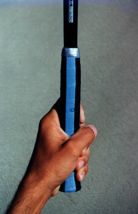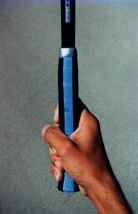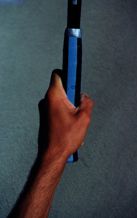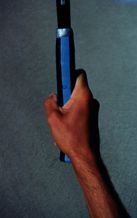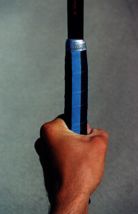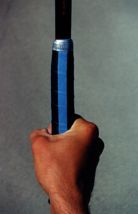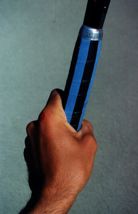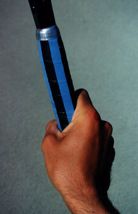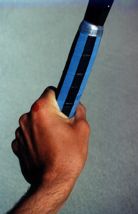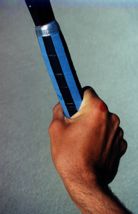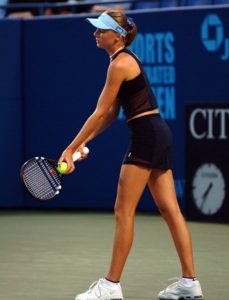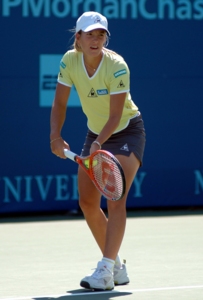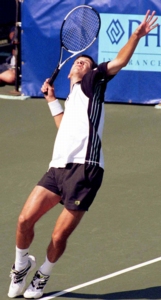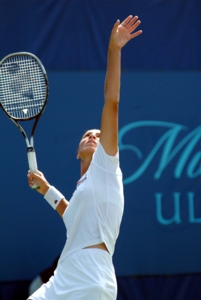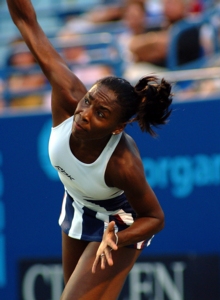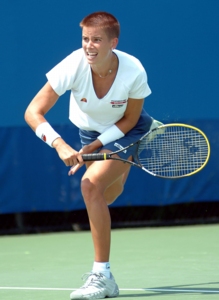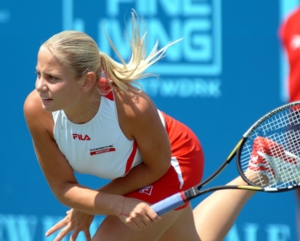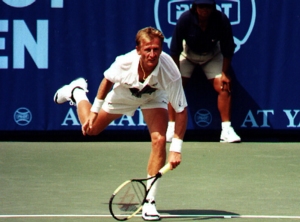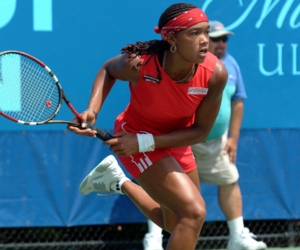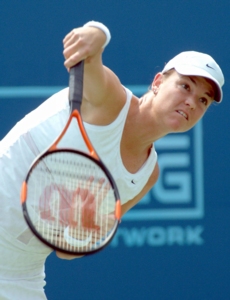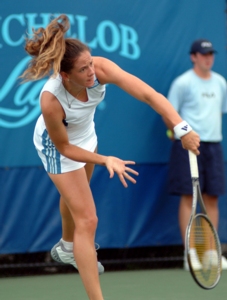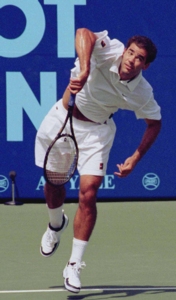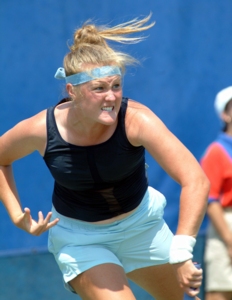December 2003 Article Turbo Tennis Archives:
Tennis Server
|

 |
Out of all of the strokes in the game of tennis, no single stroke has as much mystery, awe and fear associated with it, as does the serve. As I travel around viewing players, I see so many variations in the service motion that, at times, I wonder if a player is actually serving. The serve is the single most important stroke in our game. First, it is the only stroke that gives you two tries to execute successfully. Second, it is a stroke that is hit without the ball having bounced. Third, if we never double faulted or lost our serve, we would never lose a match. For these reasons, I make certain that I never neglect my serve. If I can make it through two sets without a double fault, I am very pleased. I will practice my serve every training day. In fact, I hit about 100 or more serves each training day. Most players have two serves…a first serve and a second serve. However, the differences between these two serves in terms of spin, pace and placement can be very different for each player. In some instances, however, the player will simply use her/his first serve hit with less pace, as her/his second serve. This is okay…if the second serve can reliably be placed in the service box…particularly if it lands deep. However, for most intermediate and advanced players, a second serve that kicks and spins is best. All serves have some common ingredients…especially when one looks at them from an integrated approach. This month’s column will focus on these common ingredients with a view toward helping you develop a consistent and effective serve…whether it be the first or second serve. To begin, I must review our tennis priorities, which apply to the serve, as well as any other stroke. First, we need to get the ball over the net. Second, we should try to get the ball to bounce deep in the service box. Third, we need to be able to control the placement of our serves. This is key. Next, we should be able to impart spin to the serve. Lastly…and I repeat, lastly, we need to impart pace to our serves. Unfortunately, so many players begin their games with an effort to hit aces. This is usually an exercise in futility. For every ace, there are probably three to five faults. Any fault is a wasted serve opportunity. The goal is to get as many first serves in the box as is possible. The best way to take pressure off of your second serve is to hit first serves in. Likewise, the best way to take pressure off of your first serve is to have a very reliable second serve. My point is simple. I have seen players with serves that have little or no pace win points off of their serves simply because the serve is in the box, lands deep in the box and is directed at the opponent’s weaker wing. I have seen matches lost because players who want to hit the big serve all the time are hitting faults. Obviously, hitting aces, if one can, is a good thing!!! However, few of us are truly blessed with this type of serve. If we were, we would probably be on the tours. Most writing about the serve, today, addresses what some call the "kinetic chain of motion." By this, the teachers and coaches mean that a fluid, smooth and complete service motion is the most important ingredient from a viewpoint of form and technique. When we have this flow, we are moving without jerks, staining or any "hitches" (little pauses in our service motion). The single best technique I know to help with kinetic flow does not involve using a racquet. Simply, go to a court and take your hopper of balls. Instead of practicing serves, go to the baseline and throw serves into the proper service box. Try to imagine that you are a pitcher who is playing American baseball. Try to serve with a pitching motion. By this, I mean that you setup, begin the pre-throwing motion, release the ball at the top of your delivery arc, and that you finish with a complete throwing motion. If you perform this correctly, you will find that there is a natural weight transfer from the back foot to the front. You will also find that you are standing in a somewhat closed stance as you pitch the ball. Your finish will be complete and your throwing arm will cross the front of your body. I think that women frequently do not have the same service weapons and their male counterparts because they have not had as much experience throwing balls like a pitcher. This is particularly true of women from Europe, where baseball may never be played. Although my anecdotal insight is not statistically proven, I do believe this to be true. So, my first piece of advice is to spend some time throwing serves…not actually serving. I do this drill religiously, at least once per week. It really helps me to regain or maintain a proper serve motion. Unlike most integrated strokes, the serve begins with no motion at all. Instead, we develop pre-serve rituals. Usually, we stand at the baseline, pause, bounce the ball a few times, look at our opponent, and then, we begin the service motion. A key ingredient in developing a consistent serve is to have consistent rituals for all serves. By ritualizing your pre-service, you will find that there is a mental consistency that greatly helps the consistency of your actual serve. Stance in the serve should be more closed than open. New players to the game, often times, will face the net as they serve. This stance does not allow for the body rotation, knee bend and weight transfer that are necessary ingredients in a good serve. Again, practicing serves by tossing or pitching a ball, is a great way to discover the specific stand that is right for you!!! Grips can vary greatly when it comes to the serve. Most players begin to serve with an Eastern Forehand Grip. This usually feels comfortable and provides an immediate sense of pace. Here is the Eastern Forehand Grip. However, the major drawback to the Eastern Forehand Grip when used to serve is that it does not allow for a "breaking" or bending of the wrist upon impact with the tossed ball. This breaking of the wrist is very helpful in providing power without strain, and is absolutely necessary if one is serving with slice spin or topspin. Additionally, using the Eastern Forehand Grip will probably force you to serve with a more open stance. This stance will not really allow for a true kinetic chain of motion. Instead, you will find that you are probably hitting the serve with arm power…not body power. So, I recommend one of several other grips. The Continental Grip: The Hammer Grip (which is really a closed fisted Continental Grip) and the Eastern Backhand Grip are all useful grips for the serve. Some players may find that an extreme backhand grip like the Full Eastern Backhand Grip may provide added wrist snap for power and spin. Below, is the Full Eastern Backhand Grip: You need to experiment with what grips feel comfortable to you. One advantage to the Continental or Hammer Grips is that they allow for serving and volleying without any grip change. If this is your natural or preferred style of play, these grips are worth using when serving. The next component in our integrated approach is stance. The stance should be somewhat, if not completely, closed (John McEnroe uses a completely closed stance when he serves). Here is a picture of Daniela Hantuchnova in proper stance. In this picture, you will also note that she is pausing before beginning her actual service motion. This is an important part of the integrated approach. I suggest you use the following "flow chart" in developing your own pre-serve rituals.
While in this position, pause, look at your opponent and spot the part of the service box your want to hit with your serve. Here is picture of Justin Henin-Hardenne in the "ready position" looking at her opponent’s court before she begins her service motion Now, you are ready to begin the service motion. Find a pattern of rituals that feel comfortable to you and stick to them…for every serve!!! Generally, most players lean a bit backwards as they begin their tossing motion. In addition, the server should begin to rotate the upper body as this toss is executed. For righties, the rotation should be to the right…for lefties, the rotation should be to the left. Body rotation is a necessary ingredient in providing power, rhythm and spin. This part of the service motion is the most difficult to master. I believe that videotaping your serves will go a long way toward helping you understand how to modify this part of your service motion. Watch the pros. Then, watch yourself. In a very short time, you will have the insights necessary to adjust your service motion. The knee bend part of the serve seems to be an extremely difficult part of the kinetic chain to include in a player’s service motion. Bend the knees too early and there is no benefit. Bend the knees too late and you will develop a "hitch" in your service motion. In my mind, the key to understanding when you need to bend the knees in the service motion depends on the height of the toss. There is no one best toss height. I use a very low toss (a la Roscoe Tanner). For me, this minimizes any impact of wind and allows for a very economical motion. I do not, however, have a severe knee bend in my motion. Higher tosses lend themselves to deeper knee bend in the motion. Here is a picture of Tim Henman. Notice his knee bend which is at its deepest when the ball has reached its maximum height and is dropping back down. You can see that his body is coiled to hit up and forward on the tossed ball. These are the two cues that one needs to keep in mind as he/she develops a fluid and effective service motion. In the following picture we see Rita Grande in the same position…ready to uncoil and to hit up and forward. As you make contact with the ball in your service motion, I encourage you to try very hard to make your head remain motionless during the moment of impact and for a fraction of a second after making contact. Dropping the head too quickly can make the ball go into the net. In the picture below, Venus Williams actually netted this serve. I made a note of this when I took this image. I am not surprised, in that, she dropped her head at the moment of impact. If you have practiced the "pitching serve" described above, you should find that there is a natural weight transfer from the back foot to the front as you make contact with the ball. The body rotation and knee bend in your motion should uncoil at this moment of impact, as well. If you are hitting the ball upward and forward, you will probably find that your serve clears the net with some margin for error and lands in the box…deep and with considerable pace. Powerful serves are best generated by the total kinetic motion…not by simple arm/shoulder strength. In fact, your arm should be totally relaxed throughout the service motion. With practice, you will find a motion and timing that are most desirable…but it may take some practice. The finish of any stroke is particularly important. When serving there are two distinct finishes. For first serves and for some slice serves (those hit with a Continental Grip or Hammer Grip) the proper finish should be across the front of the body…the same way a baseball pitcher pitches the ball. Here are some finishes that illustrate this type of finish: To a greater or lesser degree, each of these finishes place the racquet moving directly across the body. With slice serves that are hit with an Eastern Backhand or Full Eastern Backhand Grip the finish should actually be more toward the racquet side of the body and in front of the body. Here are some examples of what I mean. If you do not "own" a spin, second serve, I will not get into the details of these strokes at this time. Rather, this will be the focus of a future article. However, if you simply try to replicate the more pronated finish associated with these serves, you will probably be able to hit them with some efficacy. I should make a quick explanatory note about pronation. Pronation is the outside in twisting of the wrist that occurs as you approach the ball to make contact in the serve. If you did not twist this wrist, you would actually hit the ball with the side of the racquet frame’s head…not with the strings. If you are a righty, this motion is like unscrewing a light bulb. For lefties, the motion is the opposite…like screwing in a light bulb. I do not like to see newer or inexperienced players focus too much on pronation. I think that it occurs naturally when one serves. Focusing upon it too much is a distraction for the novice player. However, more seasoned players may really attempt to exaggerate this motion to increase pace and spin. So, let’s review what is necessary in any good serve.
Videotaping your service motion is a must, in my opinion. Once you see your motion, you will probably know immediately what you need to do to come up with a more fluid, smooth and efficient serve. Patience and persistence are attributes of the person who develops a great serve. Some players, like Goran Ivanisevic are blessed with naturally powerful and efficient serves. However, we mortals are probably going to have to serve a lot of practice serves before we arrive at the right combination of elements. In my mind, the key to a great serve is keeping it smooth and simple. Power, spin, etc. are desirable…but a fluid serve that has placement, depth and can be relied upon when nerves enter the equation…is priceless. Develop this type of serve and in no time, you will become a tennis overdog!
1996 - 2002 | 2003 - Present
This column
is copyrighted by Ron Waite, all rights reserved. Questions and comments
about these columns can be directed to Ron by using this form.
Ron Waite is a certified USPTR tennis instructor who took up the game
of tennis at the age of 39. Frustrated with conventional tennis methods
of instruction and the confusing data available on how to learn the
game, Ron has sought to sift fact from fiction. In his seven years of
tennis, Ron has received USTA sectional ranking four years, has successfully
coached several NCAA Division III men's and women's tennis teams to
post season competition, and has competed in USTA National singles tournaments.
Ron has trained at a number of tennis academies and with many of the
game's leading instructors.
In addition to his full-time work as a professor at Albertus Magnus
College, Ron photographs ATP tour events for a variety of organizations
and publications. The name of his column, TurboTennis, stems from his
methods to decrease the amount of time it takes to learn and master
the game of tennis.
|



October 2022 Tennis Anyone: Patterns in Doubles by John Mills. September 2022 Tennis Anyone: Short Court by John Mills. |
 You will join 13,000 other subscribers in receiving news of updates to the Tennis Server along with monthly tennis tips from tennis pro Tom Veneziano.
You will join 13,000 other subscribers in receiving news of updates to the Tennis Server along with monthly tennis tips from tennis pro Tom Veneziano. 
